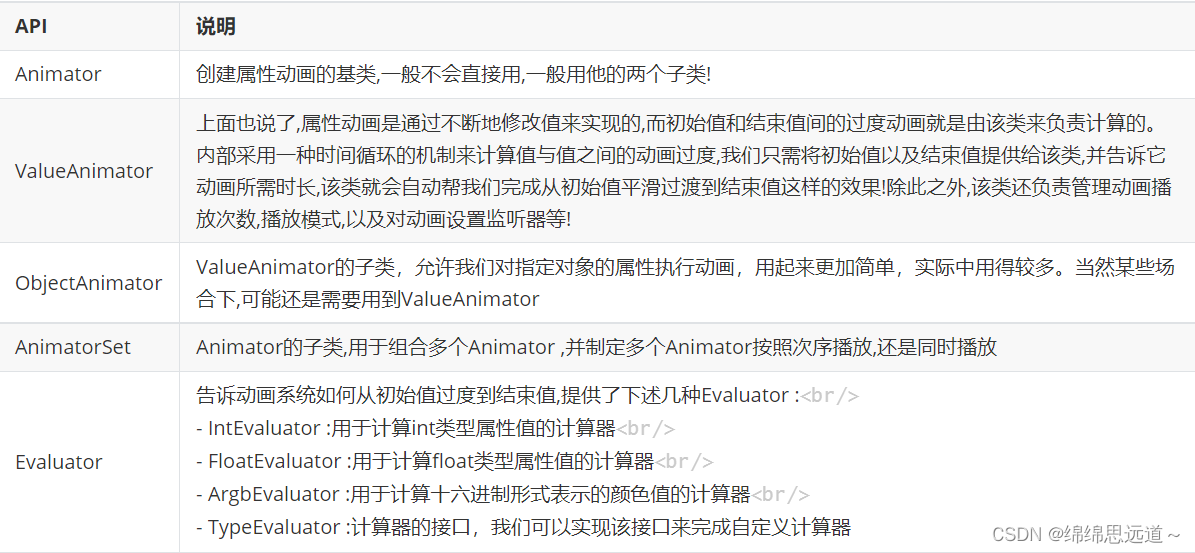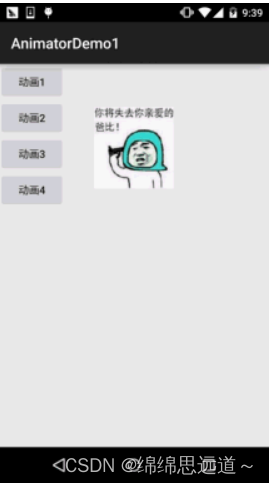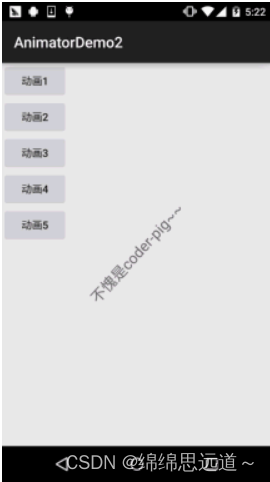1.属性动画简介
接下来我们学习Android动画中的第三种动画——属性动画(Property Animation)
Animation一般动画就是我们前面学的帧动画和补间动画!Animator则是本节要讲的属性动画!
1.1为什么要用属性动画
-
补间动画功能比较单调,只有四种动画(透明度,旋转,倾斜和位移)
-
补间动画针对的对象只是UI控件
-
补间动画只是改变View的显示效果,不会去改变View的属性
eg:左边的按钮移到右边,但是此时的按钮其实还停留在左边,假如你去点右面的按钮,是不会触发按钮的点击事件的~
1.2属性动画是什么
-
Andoid 3.0引入,可以说是补间动画的增强版,不止可以实现四种动画效果,可以定义任何属性的变化;
-
执行动画的对象不只是U控件。可以对任何对象执行动画(不管是否显示在屏幕上)
-
属性动画通过对目标对象进行赋值来修改其属性,上面那个按钮问题就不存在了~
1.3属性动画常用API
见下图:

2.ValueAnimator简单使用
2.1使用流程
-
调用ValueAnimator的ofInt(),ofFloat()或ofObject()静态方法创建ValueAnimator实例
-
调用实例的setXxx方法设置动画持续时间,插值方式,重复次数等
-
调用实例的addUpdateListener添加AnimatorUpdateListener监听器,在该监听器中 可以获得ValueAnimator计算出来的值,你可以值应用到指定对象上
-
调用实例的start()方法开启动画! 另外我们可以看到ofInt和ofFloat都有个这样的参数:float/int... values代表可以多个值!
2.2实例:

布局文件:activity_main.xml,非常简单,四个按钮,一个ImageView
<LinearLayout xmlns:android="http://schemas.android.com/apk/res/android"
android:id="@+id/ly_root"
android:layout_width="match_parent"
android:layout_height="match_parent"
android:orientation="vertical">
<Button
android:id="@+id/btn_one"
android:layout_width="wrap_content"
android:layout_height="wrap_content"
android:text="动画1" />
<Button
android:id="@+id/btn_two"
android:layout_width="wrap_content"
android:layout_height="wrap_content"
android:text="动画2" />
<Button
android:id="@+id/btn_three"
android:layout_width="wrap_content"
android:layout_height="wrap_content"
android:text="动画3" />
<Button
android:id="@+id/btn_four"
android:layout_width="wrap_content"
android:layout_height="wrap_content"
android:text="动画4" />
<ImageView
android:id="@+id/img_babi"
android:layout_width="wrap_content"
android:layout_height="wrap_content"
android:layout_gravity="center"
android:background="@mipmap/img_babi" />
</LinearLayout>接着到MainActivity.java, 首先需要一个修改View位置的方法,这里调用moveView()设置左边和上边的起始坐标以及宽高!
接着定义了四个动画,分别是:直线移动,缩放,旋转加透明,以及圆形旋转!
然后通过按钮触发对应的动画~
public class MainActivity extends AppCompatActivity {
private Button btn_one;
private Button btn_two;
private Button btn_three;
private Button btn_four;
private ImageView iv_babi;
private LinearLayout ly_root;
@Override
protected void onCreate(Bundle savedInstanceState) {
super.onCreate(savedInstanceState);
setContentView(R.layout.activity_main);
iv_babi = findViewById(R.id.iv_babi);
ly_root = findViewById(R.id.ly_root);
btn_one = findViewById(R.id.btn_one);
btn_two = findViewById(R.id.btn_two);
btn_three = findViewById(R.id.btn_three);
btn_four = findViewById(R.id.btn_four);
btn_one.setOnClickListener(new View.OnClickListener() {
@Override
public void onClick(View view) {
//获取总布局的宽和高
int width = ly_root.getWidth();
int height = ly_root.getHeight();
ValueAnimator va = ValueAnimator.ofInt(height,0,height/4,height/2,height/4*3,height);
va.setDuration(3000l);
va.addUpdateListener(new ValueAnimator.AnimatorUpdateListener() {
@Override
public void onAnimationUpdate(ValueAnimator valueAnimator) {
int x = width/2;
int y = (int) va.getAnimatedValue();
moveView(iv_babi,x,y);
}
});
va.setInterpolator(new LinearInterpolator());
va.start();
}
});
btn_two.setOnClickListener(new View.OnClickListener() {
@Override
public void onClick(View view) {
final float scale = 0.5f;
AnimatorSet scaleSet = new AnimatorSet();
ValueAnimator vaSmall =ValueAnimator.ofFloat(1.0f,scale);
vaSmall.setDuration(500);
ValueAnimator vaLarge = ValueAnimator.ofFloat(scale,1.0f);
vaLarge.setDuration(500);
vaSmall.addUpdateListener(new ValueAnimator.AnimatorUpdateListener() {
@Override
public void onAnimationUpdate(ValueAnimator valueAnimator) {
float scale = (float) valueAnimator.getAnimatedValue();
iv_babi.setScaleX(scale);
iv_babi.setScaleY(scale);
}
});
vaLarge.addUpdateListener(new ValueAnimator.AnimatorUpdateListener() {
@Override
public void onAnimationUpdate(ValueAnimator valueAnimator) {
float scale = (float) valueAnimator.getAnimatedValue();
iv_babi.setScaleX(scale);
iv_babi.setScaleY(scale);
}
});
scaleSet.play(vaLarge).after(vaSmall);
scaleSet.start();
}
});
btn_three.setOnClickListener(new View.OnClickListener() {
@Override
public void onClick(View view) {
int width = ly_root.getWidth();
int height = ly_root.getHeight();
final int R = width/4;
ValueAnimator va = ValueAnimator.ofFloat(0,(float) (2.0f*Math.PI));
va.setDuration(1000);
va.addUpdateListener(new ValueAnimator.AnimatorUpdateListener() {
@Override
public void onAnimationUpdate(ValueAnimator valueAnimator) {
float t = (float) valueAnimator.getAnimatedValue();
int x =(int) (R* Math.sin(t)+width/2);
int y =(int) (R* Math.cos(t)+height/2);
moveView(iv_babi,x,y);
}
});
va.setInterpolator(new DecelerateInterpolator());
va.start();
}
});
btn_four.setOnClickListener(new View.OnClickListener() {
@Override
public void onClick(View view) {
ValueAnimator va = ValueAnimator.ofInt(0,360);
va.setDuration(1000l);
va.addUpdateListener(new ValueAnimator.AnimatorUpdateListener() {
@Override
public void onAnimationUpdate(ValueAnimator valueAnimator) {
int rotate = (Integer) valueAnimator.getAnimatedValue();
iv_babi.setRotation(rotate);
float fractionValue = valueAnimator.getAnimatedFraction();
iv_babi.setAlpha(fractionValue);
}
});
va.setInterpolator(new DecelerateInterpolator());
va.start();
}
});
}
private void moveView(View view,int rawX,int rawY){
int left = rawX- view.getWidth()/2;
int top = rawY - view.getHeight();
int weight = left + view.getWidth();
int height = top+ view.getHeight();
view.layout(left,top,weight,height);
}好的,使用的流程非常简单,先创建ValueAnimator对象,调用ValueAnimator.ofInt/ofFloat 获得,然后设置动画持续时间,addUpdateListener添加AnimatorUpdateListener事件监听, 然后使用参数animation的getAnimatedValue()获得当前的值,然后我们可以拿着这个值 来修改View的一些属性,从而形成所谓的动画效果,接着设置setInterpolator动画渲染模式, 最后调用start()开始动画的播放
3.ObjectAnimator简单使用
比起ValueAnimator,ObjectAnimator显得更为易用,通过该类我们可以直接 对任意对象的任意属性进行动画操作!没错,是任意对象,而不单单只是View对象, 不断地对对象中的某个属性值进行赋值,然后根据对象属性值的改变再来决定如何展现 出来!比如为TextView设置如下动画: ObjectAnimator.ofFloat(textview, "alpha", 1f, 0f); 这里就是不断改变alpha的值,从1f - 0f,然后对象根据属性值的变化来刷新界面显示,从而 展现出淡入淡出的效果,而在TextView类中并没有alpha这个属性,ObjectAnimator内部机制是: 寻找传输的属性名对应的get和set方法~,而非找这个属性值! 不信的话你可以到TextView的源码里找找是否有alpha这个属性! 好的,下面我们利用ObjectAnimator来实现四种补间动画的效果吧~
3.1实例
先看一下效果图:

代码实现如下:
布局直接用的上面那个布局,加了个按钮,把ImageView换成了TextView,这里就不贴代码了, 直接上MainActivity.java部分的代码,其实都是大同小异的~
public class MainActivity3 extends AppCompatActivity implements View.OnClickListener {
private Button button1;
private Button button2;
private Button button3;
private Button button4;
private Button button5;
private LinearLayout ly_root;
private TextView tv_show;
private int height;
private ObjectAnimator animator1;
private ObjectAnimator animator2;
private ObjectAnimator animator3;
private ObjectAnimator animator4;
private AnimatorSet animSet;
@Override
protected void onCreate(Bundle savedInstanceState) {
super.onCreate(savedInstanceState);
setContentView(R.layout.activity_main3);
bindViews();
initAnimator();
}
@Override
public void onClick(View view) {
switch (view.getId()) {
case R.id.button1:
animator1.setDuration(3000l);
animator1.start();
break;
case R.id.button2:
animator2.setDuration(3000l);
animator2.start();
break;
case R.id.button3:
animator3.setDuration(3000l);
animator3.start();
break;
case R.id.button4:
animator4.setDuration(3000l);
animator4.start();
break;
case R.id.button5:
//将前面的动画集合到一起~
animSet = new AnimatorSet();
animSet.play(animator4).with(animator3).with(animator2).after(animator1);
animSet.setDuration(5000l);
animSet.start();
break;
case R.id.tv_show:
Toast.makeText(MainActivity3.this, "这也可以点???", Toast.LENGTH_SHORT).show();
break;
}
}
private void bindViews() {
ly_root = (LinearLayout) findViewById(R.id.ly_root);
button1 = (Button) findViewById(R.id.button1);
button2 = (Button) findViewById(R.id.button2);
button3 = (Button) findViewById(R.id.button3);
button4 = (Button) findViewById(R.id.button4);
button5 = (Button) findViewById(R.id.button5);
tv_show = (TextView) findViewById(R.id.tv_show);
height = ly_root.getHeight();
button1.setOnClickListener(this);
button2.setOnClickListener(this);
button3.setOnClickListener(this);
button4.setOnClickListener(this);
button5.setOnClickListener(this);
tv_show.setOnClickListener(this);
}
private void initAnimator(){
animator1 = ObjectAnimator.ofFloat(tv_show, "alpha", 1f, 0f, 1f, 0f, 1f);
animator2 = ObjectAnimator.ofFloat(tv_show, "rotation", 0f, 360f, 0f);
animator3 = ObjectAnimator.ofFloat(tv_show, "scaleX", 2f, 4f, 1f, 0.5f, 1f);
animator4 = ObjectAnimator.ofFloat(tv_show, "translationY", height / 8, -100, height / 2);
}
}
4.使用XML来编写动画
使用XML来编写动画,画的时间可能比Java代码长一点,但是重用起来就轻松很多! 对应的XML标签分别为:<animator><objectAnimator><set> 相关的属性解释如下:
-
android:ordering:指定动画的播放顺序:sequentially(顺序执行),together(同时执行)
-
android:duration:动画的持续时间
-
android:propertyName="x":这里的x,还记得上面的"alpha"吗?加载动画的那个对象里需要 定义getx和setx的方法,objectAnimator就是通过这里来修改对象里的值的!
-
android:valueFrom="1" :动画起始的初始值
-
android:valueTo="0" :动画结束的最终值
-
android:valueType="floatType":变化值的数据类型
4.1实例:
animator/property_animator.xml
<?xml version="1.0" encoding="utf-8"?>
<set xmlns:android="http://schemas.android.com/apk/res/android"
android:ordering="together" >
<objectAnimator
android:duration="3000"
android:propertyName="translationX"
android:valueFrom="-500"
android:valueTo="0"
android:valueType="floatType" >
</objectAnimator>
<objectAnimator
android:duration="3000"
android:propertyName="rotation"
android:repeatCount="3"
android:valueFrom="0"
android:valueTo="360"
android:valueType="floatType" >
</objectAnimator>
</set>加载我们的动画文件:
public class MainActivity4 extends AppCompatActivity {
private TextView tv_show;
private Button btn_start;
@Override
protected void onCreate(Bundle savedInstanceState) {
super.onCreate(savedInstanceState);
setContentView(R.layout.activity_main4);
btn_start = findViewById(R.id.btn_start);
tv_show = findViewById(R.id.tv_show);
Animator animator = AnimatorInflater.loadAnimator(MainActivity4.this, R.animator.property_animator);
animator.setTarget(tv_show);
tv_show.setOnClickListener(new View.OnClickListener() {
@Override
public void onClick(View view) {
Toast.makeText(MainActivity4.this, "没想到吧,我也可以点~~~", Toast.LENGTH_SHORT).show();
}
});
btn_start.setOnClickListener(new View.OnClickListener() {
@Override
public void onClick(View view) {
animator.start();
}
});
}
}